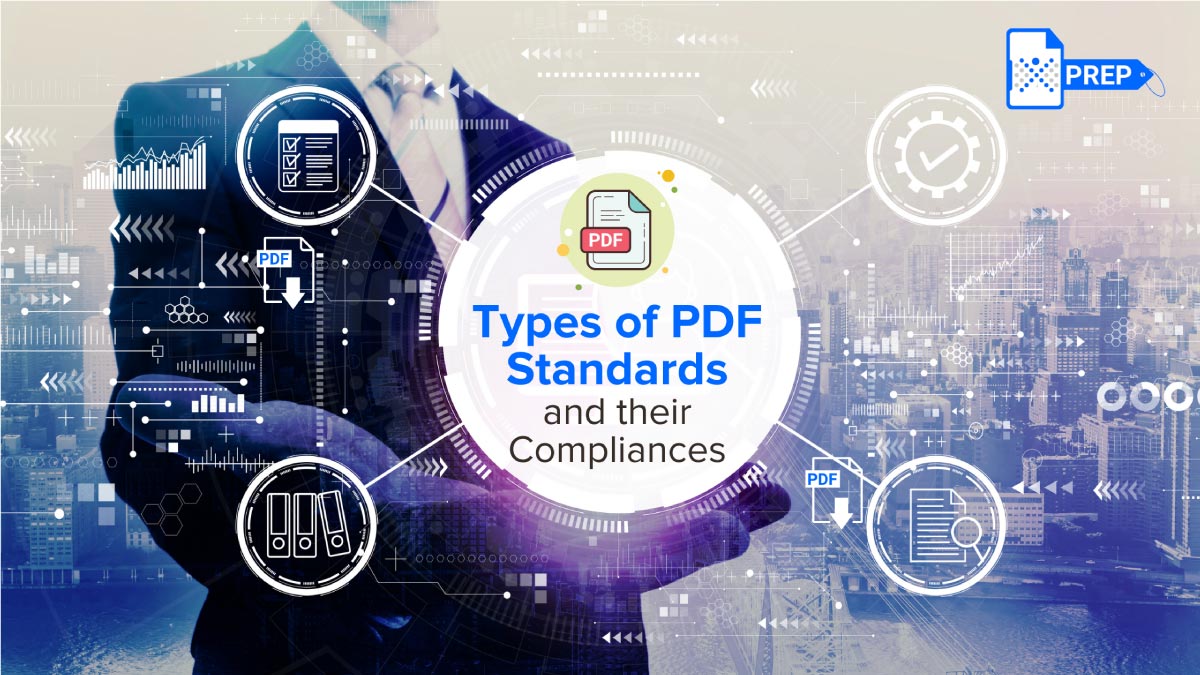The PDF, also known as Portable Document Format is among the most commonly used file formats. Any document that is converted to or saved in PDF can be saved using a certain format determined by the document’s intended use. The flexibility of PDF allows it to be utilized across a variety of sectors and businesses.
Due to this flexible nature of the PDF it requires specific quality standards to ensure interoperability , safe access, secure & safe printing and sharing of documents. The International Standards Organization (ISO) has established standards for PDF formats. There are eight different types of PDF Standards & Compliances – six formulated according to ISO and two by other private organizations.
ISO-defined PDF standards compliance
The ISO defines formulae to ensure the efficiency of products or services across industries, otherwise called ‘Standards.’ ISO has defined each of the standards based on the purpose of the documents. So, how your PDF will be viewed, printed, stored, or archived will determine the choice of your PDF standard.
1. PDF – General standard
The general PDF standard is used in-office or in-house for sharing and viewing online.
2. PDF/A – Long-term archiving
The PDF/A format is primarily used for document management, developed especially for long-term document storage by archivists, compliance managers, and record managers. Public institutions and businesses benefit from being PDF/A compliant because digital documents are stored permanently in this standard.
All versions of this standard, from PDF/A-1, will be valid forever. However, using the most recent parts of the standard, like PDF/A-4, is practical as they natively support the current PDF version (PDF 2.0). PDF/A-4 reduces conversion efforts and allows most PDF functions.
3. PDF/E – Engineering
The PDF/E compliance standard is designed for documents used in engineering workflows, especially by architects, construction professionals, and manufacturing product teams. This PDF standard addresses costs and the convenience of storing documents with large format drawings, multimedia, form fields, and rights management.
Like other PDF standards, PDF/E specifies how authors create the document. The compliance standard allows for security and encryption, digital rights, digital signatures, and interactive media.
4. PDF/X – Exchange and Printing
The PDF/X is known as PDF for Exchange. It best suits print and creative professionals and graphic designers to transfer visual art content effectively. This standard ensures high quality and professional document standards.
There are 7 standards within PDF/X – PDF/X-1a, PDF/X-3, PDF/X-4, PDF/X-4p, PDF/X-5g, PDF/X-5n and PDF/X-5pg. These versions define compliance standards for embedding fonts, color profiles, storage of graphical elements, object transparency, and more.
5. PDF/UA – Accessibility
“UA” stands for universal accessibility. The requirements for a PDF/UA-compliant file define how texts, images, alt-texts, and forms are created so that assistive technologies/ devices can access them effectively. The PDF/UA compliance standard defines regulations for a document’s normally non-displayed tagging structure, which defines reading order and structure in headings, paragraphs, columns, tables, and alternative texts for images. The standard helps meet legal requirements for unrestricted access to electronic information in public institutions, insurance companies, and banks.
6. PDF/VT – Printing
The PDF/VT standard is based on components of the PDF/X standard. Like PDF/X, it is used by print professionals. This compliance standard allows data customization within files, such as bank statements, business invoices, or personalized marketing material. It is the best format for variable data printing and transactional printing.
PDF standards from other organizations
These standards are defined for specific document needs by other organizations.
1. PAdES
This PDF standard is established for digital signatures in the European Union and standardizes paperless transactions that conform to EU legislation.
2. PDF/H – Healthcare
The PDF/H standard defines best practices and implementation guidelines to facilitate the capture, exchange, preservation, and protection of healthcare information. The guidelines make it easy for patients and doctors to share medical information. The PDF standard considers factors like security and privacy, satisfying provisions laid out by the Health Insurance Portability and Accountability Act (HIPAA).
Converting PDFs to other standards
You can easily convert available PDFs to any standard-compliant PDF using the Standard wizard or Acrobat Distiller tool by Adobe Acrobat. The wizard explains the intents of specific formats as it guides you through the process. You can also save a general PDF as a PDF/X, PDF/A, or PDF/E, provided it complies with the specified requirements.
Combining PDF standards
The current PDF standards allow the creation of PDF files compliant with multiple subsets without much effort. There are many types of pdf software in addition to PDF creation programs, such as Microsoft Word and Adobe InDesign, enabling subsequent conversion – even in automated workflows.
You can now scan an invoice, eSign it using PDF Editor, and email it halfway across the globe within seconds! That is how PDFs have ‘revolutionized’ document management. That being said, if you save or create PDFs in the wrong standard, you may compromise the data and integrity of the document in the long run. Understanding and knowing your PDF options enables you to be compliant and optimize the quality of your document for effective viewing, sharing, printing, or archiving purposes.

